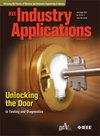基于OSO-AI控制和PSPO MPPT的单相两级并网太阳能光伏系统
IF 4.5
2区 工程技术
Q2 ENGINEERING, ELECTRICAL & ELECTRONIC
引用次数: 0
摘要
本文介绍了一种用于单相两级并网太阳能光伏(SPV)系统的优化二阶自适应积分器(OSO-AI)控制和开创性的预测自调谐摄动与观测(PSPO)最大功率点跟踪(MPPT)技术,旨在提高配电网的电能质量。该架构结构包括一个升压转换器和一个电压源转换器(VSC),旨在最大限度地提取太阳能,并确保以最小的谐波无缝集成电网。系统的共耦合点(PCC)具有两种不同的非线性载荷。提出的OSO-AI控制算法能有效地管理VSC,提供无功补偿,提高电网稳定性。在硬件系统上进行了大量的仿真测试和严格的实验室实验,以验证其对动态负载扰动、电网扰动和波动太阳辐照度的鲁棒性。实验结果证明了该方法的鲁棒性,总谐波失真(THD)低于5%。研究结果表明,该系统符合严格的电能质量规范,验证了PSPO MPPT和OSO-AI控制在优化并网SPV系统性能方面的有效性。本文章由计算机程序翻译,如有差异,请以英文原文为准。
Single-Phase Two-Stage Grid Integrated Solar PV System With OSO-AI Control and PSPO MPPT
This paper introduces an Optimized Second-Order Adaptive Integrator (OSO-AI) control and ground-breaking Predictive Self-Tuned Perturb & Observe (PSPO) Maximum Power Point Tracking (MPPT) technique for a single-phase two-stage grid integrated Solar Photovoltaic (SPV) system, aimed at enhancing power quality in distribution networks. The architectural structure includes a boost converter and a Voltage Source Converter (VSC), designed to maximize solar power extraction and ensure seamless grid integration with minimal harmonics. The system’s Point of Common Coupling (PCC) have two distinct non-liner loads. The proposed OSO-AI control algorithm effectively manages the VSC to provide reactive power compensation and improve grid stability. Extensive simulation tests and rigorous laboratory experiments on hardware system are performed to verify its robustness against dynamic load perturbations, grid disturbances, and fluctuating solar irradiance. The experimental results demonstrate the robustness of the proposed approach, with total harmonic distortion (THD) under 5%. The findings highlight the system’s compliance with stringent power quality norms, validating the effectiveness of the PSPO MPPT and OSO-AI control in optimizing performance in grid-connected SPV systems.
求助全文
通过发布文献求助,成功后即可免费获取论文全文。
去求助
来源期刊

IEEE Transactions on Industry Applications
工程技术-工程:电子与电气
CiteScore
9.90
自引率
9.10%
发文量
747
审稿时长
3.3 months
期刊介绍:
The scope of the IEEE Transactions on Industry Applications includes all scope items of the IEEE Industry Applications Society, that is, the advancement of the theory and practice of electrical and electronic engineering in the development, design, manufacture, and application of electrical systems, apparatus, devices, and controls to the processes and equipment of industry and commerce; the promotion of safe, reliable, and economic installations; industry leadership in energy conservation and environmental, health, and safety issues; the creation of voluntary engineering standards and recommended practices; and the professional development of its membership.
 求助内容:
求助内容: 应助结果提醒方式:
应助结果提醒方式:


